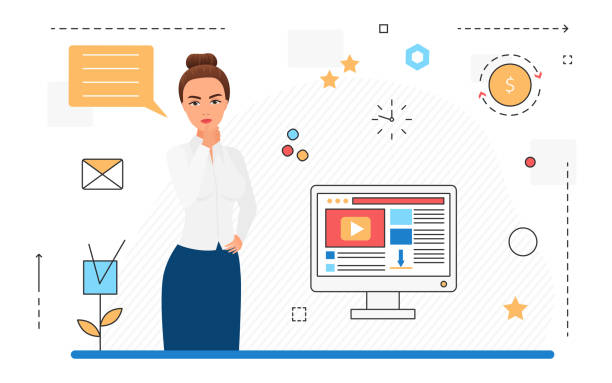Introduction to Modern UI Website Design
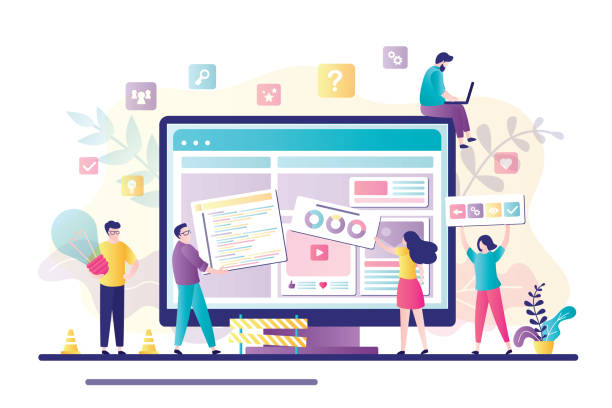
In today’s digital world, the first impression of a business or product is often formed through its website.
In this regard, modern UI website design is not just a competitive advantage but an undeniable necessity.
Simply having a website is no longer enough; users expect a smooth, pleasant, and visual experience.
The importance of #User_Interface (#UI) and #User_Experience (#UX) goes beyond mere aesthetics; they directly impact user engagement, conversion rates, and ultimately, a business’s online success.
In the past, websites were primarily information-centric, with less attention paid to visual and interactive aspects.
However, with the transition to the digital age and increased internet access through various devices, the need for a modern user interface became more pronounced.
This evolution means that websites must be designed not only to look good but also to be easy and enjoyable to use.
This is where the concept of modern UI website design comes into play.
This new approach focuses on creating experiences that engage users, anticipate their needs, and guide them toward their goals on the website.
This includes the educational, explanatory, and analytical aspects of the design processes.
In the rest of this article, we will delve deeper into the pillars, challenges, and future of this exciting field to gain a more comprehensive understanding of how to create an exceptional user experience.
Research shows that 80% of customers trust companies with a professional website more. Does your current website attract this trust?
With Rasaweb corporate website design services, solve the problem of customer distrust and a weak online image forever!
✅ Create a professional image and increase customer trust
✅ Attract more sales leads and grow your business
⚡ Get free consultation
Key Pillars of a Modern and Efficient User Interface

A modern user interface goes beyond beautiful colors and attractive fonts; it’s a set of principles and techniques combined to create an unparalleled user experience.
One of the most important pillars is responsiveness or responsive design, which ensures your website displays and functions correctly on any device, from desktop to mobile and tablet.
This is a specialized and guidance principle that cannot be overlooked.
Minimalism or simplicity is another principle that emphasizes removing unnecessary elements and focusing on the main content.
This approach helps users access the information they need without distraction.
Visual and intuitive navigation is also crucial; users should be able to easily navigate your website and find what they are looking for.
This includes designing clear menus, recognizable links, and a logical page structure.
Modern UI website design also involves smart use of white space, a strong visual hierarchy to highlight important information, and micro-interactions.
Micro-interactions are small animations or subtle feedbacks that enrich the user experience and give the user more control, such as a button changing color after clicking.
Finally, Accessibility is a key pillar; your website must also be usable for people with disabilities, which is not only an ethical responsibility but also a legal requirement in many countries.
All these pillars work hand-in-hand to provide a modern and attractive modern UI website design for users.
New Tools and Technologies in User Interface Design
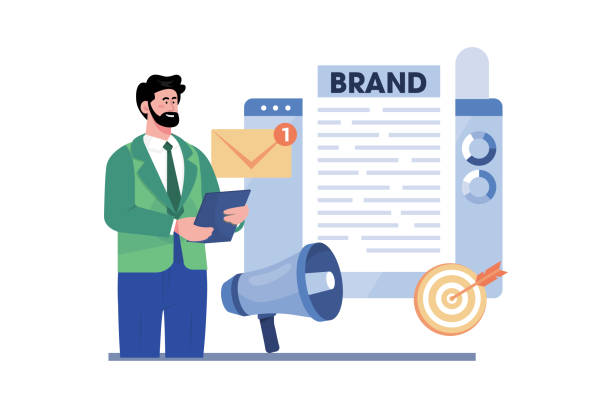
The modern UI website design industry is rapidly evolving, with new tools and technologies being released daily that simplify and streamline the design process.
Today, designers have access to a suite of powerful software that enables prototyping, visual design, and wireframing.
Among the most popular tools are Figma, Sketch, and Adobe XD, each with its unique features and advantages.
These tools also facilitate team collaboration, allowing designers to work simultaneously on a single project, which is a significant advancement in the design process.
In addition to design software, web development frameworks play a vital role in implementing a modern UI website design.
Frameworks such as React, Vue, and Angular enable the creation of interactive and dynamic user interfaces with less code and greater efficiency.
Also, CSS frameworks like Tailwind CSS and Bootstrap help developers implement responsive and beautiful designs quickly.
This educational and specialized section will be very useful for anyone looking to learn in this field.
Animation libraries like GSAP also help create captivating visual interactions.
Understanding these tools is essential for any modern web designer to turn their ideas into reality and provide the best experience for end-users.
The table below compares some of the most widely used UI design tools:
| Tool | Main Use | Strengths | Weaknesses | Suitable for |
|---|---|---|---|---|
| Figma | UI/UX design, prototyping, wireframing, team collaboration | Web-based, real-time collaboration, high comprehensiveness, numerous plugins | Requires internet connection for team work, may not be suitable for offline projects | Large teams, projects requiring real-time collaboration, design systems |
| Sketch | UI/UX design, vector design | Native macOS, light and fast, rich plugin ecosystem | macOS only, lack of built-in real-time collaboration | Individual designers or small teams, Mac users |
| Adobe XD | UI/UX design, prototyping, animation | Part of Adobe ecosystem, strong animation capabilities, multiple plugins | Slightly heavier than competitors, monthly subscription | Users familiar with Adobe, projects requiring complex animations |
Psychology of Color and Form in Modern UI Website Design

The role of the psychology of color and form in a modern UI website design is deeper than it appears.
Colors are not just aesthetic; they evoke specific emotions, concepts, and reactions in users.
For example, blue is often associated with trust, calmness, and professionalism, while red can convey excitement or warning.
Choosing the right color palette should be done considering the target audience, brand message, and overall website goal.
This is a specialized and analytical aspect of design that requires research and understanding.
Likewise, typography, or the art of selecting and arranging fonts, significantly impacts readability and visual appeal.
Different fonts have different personalities and can define the tone of your website.
Proper use of visual hierarchy by using different font sizes, weights, and colors helps users quickly identify important information and navigate.
This is essential in any modern UI website design.
Furthermore, form and layout of elements are also very important.
Using grid systems and intelligent use of whitespace not only gives the website a clean and professional appearance but also improves readability and prevents visual clutter.
Every element on the page should have a specific purpose and be placed in a way that is logical and understandable for the user.
The ultimate goal is to create a pleasant and functional visual experience by leveraging the psychology of color and form, which not only attracts user attention but also guides them toward the website’s objectives.
Is your company’s website as professional and trustworthy as it should be? With specialized corporate website design by Rasaweb, create an online presence that reflects your credibility and attracts more customers.
✅ Build a powerful and professional brand image for your business
✅ Convert visitors into real customers
⚡ Get a free consultation now!
The Role of User Experience (UX) in Modern Website Design
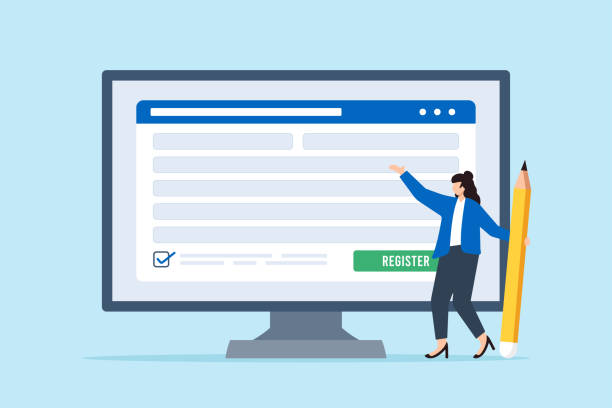
While User Interface (UI) refers to the look and feel of a product, User Experience (UX) is a broader set of factors that addresses how a user feels when interacting with a website.
UX determines whether a website is easy to use, whether it meets user needs, and whether the overall experience is positive.
For a modern UI website design, UX is the backbone; without strong UX, even the most beautiful UI cannot succeed.
This explanatory and specialized section is essential for understanding the nuances between UI and UX.
The UX design process begins with User Research.
This phase involves understanding the needs, behaviors, and motivations of target users through interviews, surveys, data analysis, and observation.
Creating Personas and Empathy Maps helps designers understand their users and create designs that are truly useful to them.
After research, designers of advanced UX website design proceed to create User Flows and wireframes to define the website’s structure and functionality.
User Testing is another crucial step where website prototypes are tested with real users to identify design weaknesses and strengths.
Feedback collected in this phase helps continuously improve the design and ensures that the final product truly meets user needs.
Good UX not only leads to user satisfaction but also significantly contributes to increased engagement, reduced bounce rates, and ultimately, online business success.
In fact, a modern UI website design without sufficient attention to UX is like a sports car without a powerful engine – beautiful but inefficient.
Responsive Design for All Devices
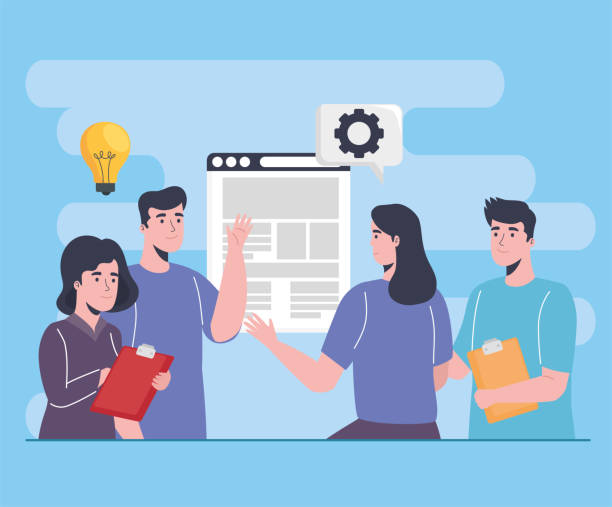
In this era where users access the internet from a wide range of devices with different screen sizes, Responsive Design is not just a choice but a standard for every modern UI website design.
The main goal of responsive design is for your website to automatically adapt to the user’s screen size and orientation without requiring separate versions.
This means a seamless and optimized user experience, regardless of whether the user is using a desktop computer, laptop, tablet, or smartphone.
This is an important guidance and explanatory point for every designer.
The “Mobile-First” approach in responsive design means that design and development start for the smallest screen (mobile phones) and then gradually scale up for larger screens (tablets and desktops).
This method ensures that the most important content and functionalities are available first for mobile users and prevents overloading devices with limited resources with unnecessary elements.
Key components of responsive design include Fluid Grids, which use percentages instead of fixed pixels for width, Flexible Images, which adapt to screen size, and Media Queries in CSS.
Media Queries allow you to apply different CSS rules based on device characteristics such as screen width, height, orientation, and resolution.
By properly implementing responsive design, you can ensure that your modern UI website design is accessible and enjoyable for all users on any device, which not only improves the user experience but also strengthens your website’s SEO ranking.
Challenges and Solutions for Modern UI Website Design
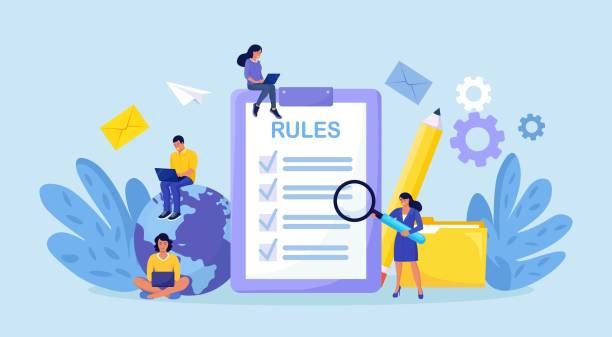
While modern UI website design offers numerous benefits, this process is not without challenges.
One of the biggest challenges is the balance between aesthetics and functionality.
Sometimes designers become so engrossed in creating a beautiful and attractive appearance that they overlook the functional and performance aspects of the website.
This can lead to designs that are visually stunning but complex or confusing for users to use.
A thought-provoking question in this area is whether beauty always takes precedence over functionality? Absolutely not.
Another challenge is performance issues.
Excessive use of animations, high-quality images, or heavy frameworks can severely reduce website loading speed.
Today’s users expect high speed, and even a few seconds of delay can lead to users leaving the website.
Lack of attention to accessibility is also a serious challenge that can hinder access for a large segment of users.
Websites must be usable for people with disabilities, including the visually impaired or blind.
Solutions to overcome these challenges include continuous user testing, Performance Optimization such as image compression and caching, and adherence to Accessibility Standards (WCAG).
Also, continuous education and knowledge updates regarding the latest trends and best practices in modern UI website design are essential.
With careful planning, frequent testing, and attention to detail, websites can be created that are both beautiful and provide an excellent user experience.
The table below shows some common challenges in modern UI/UX design and suggested solutions:
| Challenge | Explanation | Suggested Solution |
|---|---|---|
| Over-design / Excessive Complexity | Adding too many visual elements or unnecessary complexities that confuse the user. | Focus on minimalism, use simple UI principles, remove unnecessary elements. |
| Performance Issues (slowness) | Website heaviness due to large image sizes, inefficient code, or unoptimized animations. | Image optimization, code compression (CSS/JS), using CDN, Lazy Loading. |
| Lack of Accessibility | Website is not usable for people with disabilities (e.g., visually impaired). | Following WCAG guidelines, using ARIA tags, proper color contrast. |
| Inconsistency in Design | UI elements have different appearances or behaviors on different website pages. | Creating and using a Design System or component library. |
| Mismatch with User Needs | Designing without sufficient research into target users’ needs and behaviors. | Conducting in-depth user research, creating personas, frequent user testing. |
Case Study of Successful Websites with Outstanding User Interfaces
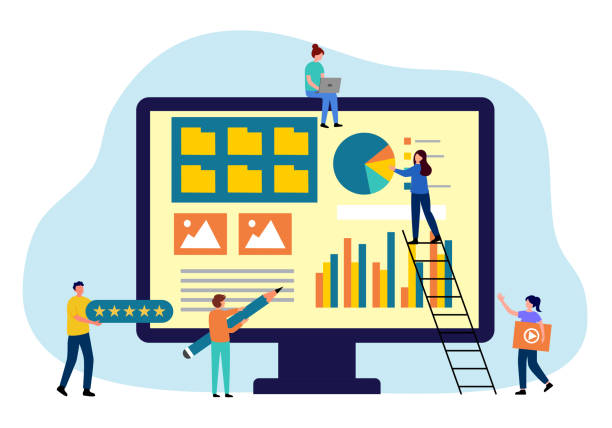
To better understand the concept of modern UI website design, nothing is better than examining real and successful examples.
Many leading companies worldwide have invested heavily in their user interface and experience design, and the results are clearly visible.
This section of the article is an analytical and engaging piece that can inspire designers.
One of the most prominent examples is Apple’s website.
Apple’s website design is a prime example of minimalism, intelligent use of white space, high-quality images, and unparalleled navigation.
Each page is designed to showcase the product at its best, with subtle animations and smooth interactions that make the user experience very enjoyable.
This website clearly demonstrates how an advanced UX website design can impact sales and branding.
Airbnb is another example where UX plays a central role.
Their user interface is not only beautiful and inviting but also greatly simplifies the process of searching, booking, and managing accommodations for users.
The focus on high-quality images of accommodations and precise search filters has significantly improved the user experience.
This website is news-oriented regarding success in user-centered design.
Stripe’s website is also an excellent example of modern UI website design for B2B products.
Despite the technical complexities of payment services, their user interface is surprisingly clean, clear, and easy to understand.
The use of descriptive images, detailed documentation, and a cohesive visual design helps developers easily work with their APIs.
These examples show how an innovative UI design and effective design can help businesses achieve their goals and build deeper connections with users.
Are you tired of your e-commerce site having visitors but no sales? Rasaweb solves your main problem with professional e-commerce website design!
✅ Significantly increase sales with targeted design
✅ Seamless user experience for your customers
⚡ Get a free consultation now!
The Future of Modern UI Website Design: AI and Virtual Reality
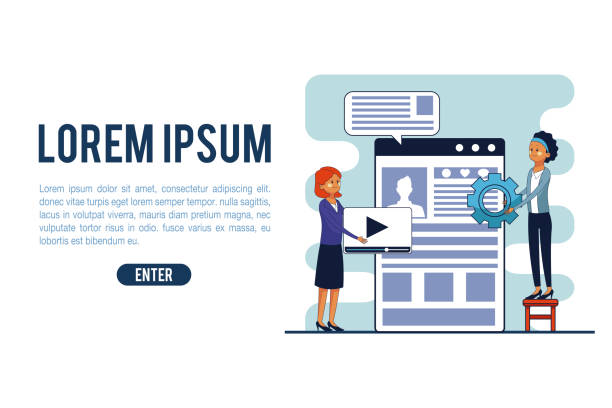
The future of modern UI website design is taking shape, and emerging technologies like Artificial Intelligence (AI) and Virtual Reality (VR) promise revolutionary changes.
This section is an analytical, news-oriented, and thought-provoking content that opens new horizons before us.
AI in Design: AI-powered design tools are emerging that can help designers automate repetitive tasks, generate initial layouts, and even personalize user interfaces based on user behavior.
AI can identify behavioral patterns and suggest interfaces that best match each user’s individual needs.
This means websites that literally “learn” and adapt to the user.
Virtual and Augmented Reality in Web: Although still in its early stages, the potential for integrating VR and AR into the web experience is immense.
Imagine being able to view products in 3D, walk through a virtual store, or interact with content in an entirely new way.
These technologies can blur the lines between the physical and digital worlds and provide unprecedented opportunities for advanced UX website design.
Furthermore, Voice User Interfaces (Voice UI) and Haptic Feedback are also gaining popularity.
Websites may soon be controllable with voice commands and provide haptic feedback for specific interactions.
These developments indicate that modern UI website design is moving towards multi-sensory and more personalized experiences.
Designers must be ready to adapt to these technologies and learn new skills to create the websites of the future.
These challenging topics expand the boundaries of modern UI website design.
How to Optimize a Modern UI Website Design?
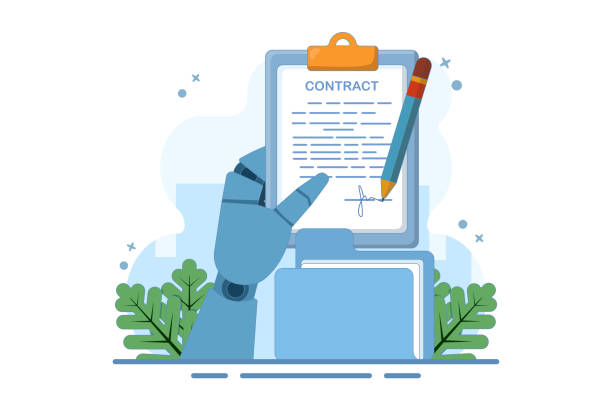
Designing a modern UI website design is only half the battle; continuous optimization is essential to ensure long-term success.
This section offers guidance and specialized advice for continuous improvement of your website.
Performance Optimization: Website loading speed is one of the most important factors in user experience and SEO.
Compressing images without reducing quality, minimizing CSS and JavaScript files, using browser caching, and leveraging Content Delivery Networks (CDNs) can significantly increase your website’s speed.
These measures are crucial for any modern UI website design.
A/B Testing: This method allows you to show different versions of a page or UI element to different groups of users and measure the performance of each version.
For example, you can test two different colors for a Call-to-Action button and see which one has a higher click-through rate.
This is a great way to make design decisions analytical and data-driven.
Web Analytics: Using tools like Google Analytics to monitor user behavior, bounce rate, popular pages, and user paths provides valuable information for optimization.
This data helps you identify the strengths and weaknesses of your modern UI website design and make data-driven decisions to improve it.
An optimized UI/UX not only keeps users satisfied but also directly impacts your business goals positively.
Remember that modern UI website design is an ongoing process and does not end with the website launch; it is just the beginning of the journey.
Frequently Asked Questions
| No. | Question | Answer |
|---|---|---|
| 1 | What does a modern user interface mean in website design? | It means designing a website that has a beautiful, attractive, and up-to-date appearance, while also being easy, intuitive, and pleasant for the user to use (emphasis on UX/UI). |
| 2 | What are the main features of a modern user interface? | It includes minimalist design, sufficient use of white space, appealing typography, a harmonious color palette, high-quality images and icons, full responsiveness, fast loading speed, and appropriate use of animations and micro-interactions. |
| 3 | Why is having a modern user interface important for a website? | It improves user experience, increases visitor trust, reduces bounce rate, increases user time on the site, strengthens the brand, and ultimately helps achieve business goals (such as sales or user acquisition). |
| 4 | What is the role of Responsive Design in a modern user interface? | Responsiveness is a crucial component; a modern UI website must display correctly and have optimal performance on all devices (mobile, tablet, desktop). |
| 5 | How does typography (font selection) affect a modern user interface? | Appropriate typography increases readability, defines information hierarchy, and plays a significant role in creating a modern visual aesthetic that aligns with brand identity. |
| 6 | What is the importance of using Whitespace in modern design? | Whitespace allows visual elements to “breathe,” prevents clutter, increases user focus on the main content, and creates a clean, professional appearance. |
| 7 | What role do Micro-interactions play in improving a modern user interface? | Micro-interactions (such as a button changing color upon click, displaying a form submission confirmation message) provide visual feedback to the user, make site usage more interactive and enjoyable, and convey a sense of attention to detail. |
| 8 | What tools are used for modern user interface design? | Common tools include Figma, Sketch, Adobe XD, and even prototyping tools. |
| 9 | How can one ensure that a modern user interface is also user-friendly (Usable)? | Through User Testing, gathering feedback from real users, adhering to Accessibility principles, and Intuitive Navigation. |
| 10 | Does modern design mean removing all graphical elements? | No, modernity means smart and purposeful use of graphical elements, colors, images, and animations to create an engaging yet functional experience, not their unnecessary removal. |
And other advertising services of Rasaweb Advertising Agency in the field of advertising
- Smart Direct Marketing: Designed for businesses seeking to increase sales through the use of real data.
- Smart Digital Branding: An effective tool for online growth through attractive UI design.
- Smart Content Strategy: An innovative service for improving SEO ranking through the use of real data.
- Smart Google Ads: Revolutionize website traffic with the help of Google Ads management.
- Smart Digital Branding: A combination of creativity and technology to increase sales through SEO-driven content strategy.
And over a hundred other services in the field of internet advertising, advertising consultation, and organizational solutions
Internet Advertising | Advertising Strategy | Advertorials
Sources
Modern UI Website Design: The Future of the Web
The Visual Revolution in Web: How Website Design Changed?
Latest UI/UX Trends in Web Design
The Importance of Responsive Design in Modern User Interface
? Take your business to the next level with Rasaweb Afarin Digital Marketing Agency services! At Rasaweb Afarin, we specialize in providing comprehensive digital solutions for the growth and development of your business. From professional website design and SEO to social media management and targeted advertising campaigns, we provide everything you need to be seen and succeed in the online space.
📍 Tehran, Mirdamad Street, next to Central Bank, Kazeroon Jonubi Alley, Ramin Alley, No. 6

